You Took My Elephant
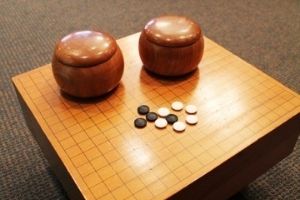
A blog post by Executive Director Marvin Pinkert.
News Flash: We have a last minute addition to tomorrow’s Dragons and Dreidels presentation. In addition to Ilene Spector’s delicious discourse on dumplings, in addition to our kosher fortune cookies and Chinese food, and on top of our great family activities and mah jongg games…yours truly, will be running a demonstration table as well.
It’s not a food demonstration – trust me, you wouldn’t want to eat what I cook. And you will also be spared a dissertation on transliteration (see my blog post of Dec.. 12), but it will be a personal passion. In honor of our celebration of East Asian-Judaic connections, I will be demonstrating about a half dozen board games with a real or imaginary Asian link. As a board game enthusiast, I reasoned that if we could make a link with mah jongg, this was surely an excuse to bring some of my other treasures out of the closet.
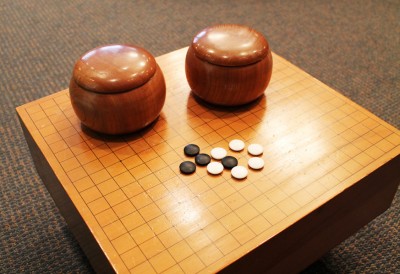 The oldest game I will be bringing with is Wei Qi (that’s the Chinese name, it’s Korean name is Paduk, but you probably know it as Go). People in China were playing this game 4,000 years ago (or about 2,000 years before dreidel). It has just three or four rules, but takes a lifetime to master. My Paduk board (since I purchased it in Korea, it only seems fair to call it Paduk) is only about 35 years old, but I still have vivid memories of carrying this monster block of wood about a mile through the streets of Seoul. Wei Qi/Paduk/Go is without doubt the most popular East Asian game internationally. Many countries have teams, including Israel. You may want to check out the website of the Israeli Go Association (Israel-go.org). Now I have to add גו to the long list of names for this game.
The oldest game I will be bringing with is Wei Qi (that’s the Chinese name, it’s Korean name is Paduk, but you probably know it as Go). People in China were playing this game 4,000 years ago (or about 2,000 years before dreidel). It has just three or four rules, but takes a lifetime to master. My Paduk board (since I purchased it in Korea, it only seems fair to call it Paduk) is only about 35 years old, but I still have vivid memories of carrying this monster block of wood about a mile through the streets of Seoul. Wei Qi/Paduk/Go is without doubt the most popular East Asian game internationally. Many countries have teams, including Israel. You may want to check out the website of the Israeli Go Association (Israel-go.org). Now I have to add גו to the long list of names for this game.
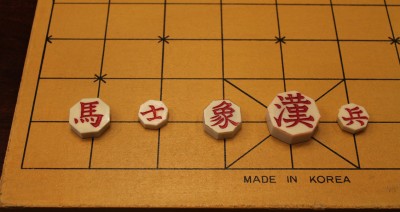 The second game I am bringing with is Xiang Qi. A relative youngster, Xiang Qi is believed to have been developed from the Indian precursor to chess about 200 B.C. Technically speaking, the set I will have on the table is actually the very closely related Korean variant called Janggi – but you can play the same games with either set. The Xiang in Xiang Qi comes from the Chinese word for elephant, one of the pieces in the game. Each piece has a Chinese character identifying it. Here is a photo of several of the pieces in my set. Can you pick out which ideogram is the elephant? (By the way, elephants are not rooks, they move more like a limited version of the bishop in chess).
The second game I am bringing with is Xiang Qi. A relative youngster, Xiang Qi is believed to have been developed from the Indian precursor to chess about 200 B.C. Technically speaking, the set I will have on the table is actually the very closely related Korean variant called Janggi – but you can play the same games with either set. The Xiang in Xiang Qi comes from the Chinese word for elephant, one of the pieces in the game. Each piece has a Chinese character identifying it. Here is a photo of several of the pieces in my set. Can you pick out which ideogram is the elephant? (By the way, elephants are not rooks, they move more like a limited version of the bishop in chess).
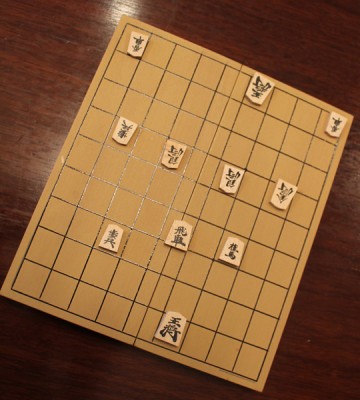
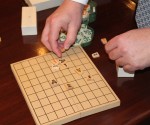 The third item on the table will be the Japanese game of Shogi. This is another cousin of chess, but it has a truly distinctive feature. The pieces are all the same color! Each piece is pointed and the direction the point is facing signifies ownership of the piece. This is not an aesthetic innovation. In Shogi, when you capture a piece it doesn’t leave the game. Instead you can drop a piece you’ve captured onto the Board on your turn, switching its allegiance. This game emerges in the 16th and 17th century in Japan, at a time when it was not uncommon for real generals to change the course of battle by changing sides. I’ve looked for a Jewish link to every game, and I believe that one of the three acknowledged American Shogi masters is a Jewish gentleman from Potomac, MD – but this still requires a little investigation. I’ll also be illustrating the child’s game of Hasami Shogi – I call it a child’s game, because my children always beat me at it.
The third item on the table will be the Japanese game of Shogi. This is another cousin of chess, but it has a truly distinctive feature. The pieces are all the same color! Each piece is pointed and the direction the point is facing signifies ownership of the piece. This is not an aesthetic innovation. In Shogi, when you capture a piece it doesn’t leave the game. Instead you can drop a piece you’ve captured onto the Board on your turn, switching its allegiance. This game emerges in the 16th and 17th century in Japan, at a time when it was not uncommon for real generals to change the course of battle by changing sides. I’ve looked for a Jewish link to every game, and I believe that one of the three acknowledged American Shogi masters is a Jewish gentleman from Potomac, MD – but this still requires a little investigation. I’ll also be illustrating the child’s game of Hasami Shogi – I call it a child’s game, because my children always beat me at it.
To round out the table I’ll be demonstrating two games that sound like they should be Chinese but really are American/German. The first of these is Chinese Checkers. This game was invented in Germany in the 1880s under the name Stern Halma (Stern = Star in German, Halma = Jump in Greek). While the shape of the board is very suggestive, I haven’t traced down any Jewish connection to the original game. However, the man who rediscovered the game and patented it as Chinese Checkers was Jack Pressman of Pressman Toys. It was a big hit in 1928. Unlike conventional checkers, you don’t capture pieces when you jump them and unlike other classic strategy games, up to six people can play at the same time.
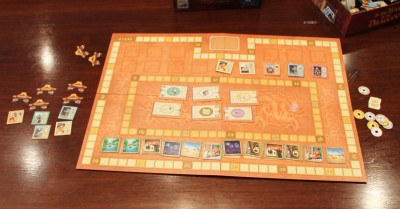
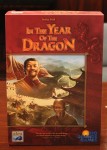 Finally, I will be illustrating the Eurogame called “In the Year of the Dragon”. The theme of the game is the cycle of life in medieval China. The reality is that the game was designed by Stefan Feld in 2011. Feld is one of dozens of game designers in Europe who has gained a following in the hobby in the last decade. Nearly 150,000 people gather in Essen, Germany each year to see the latest innovations in one of the world’s oldest pastimes. In America, a handful of companies translate the German, French and Italian games and make them accessible to thousands of avid board gamers here. My former neighbor from Skokie, IL, Jay Tummelson, and his company Rio Grande Games translated and published “In the Year of the Dragon”.
Finally, I will be illustrating the Eurogame called “In the Year of the Dragon”. The theme of the game is the cycle of life in medieval China. The reality is that the game was designed by Stefan Feld in 2011. Feld is one of dozens of game designers in Europe who has gained a following in the hobby in the last decade. Nearly 150,000 people gather in Essen, Germany each year to see the latest innovations in one of the world’s oldest pastimes. In America, a handful of companies translate the German, French and Italian games and make them accessible to thousands of avid board gamers here. My former neighbor from Skokie, IL, Jay Tummelson, and his company Rio Grande Games translated and published “In the Year of the Dragon”.
So if you are curious about games, you have another reason to come to “Dragons and Dreidels”. If not, just think about savoring those dumplings!
